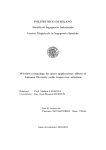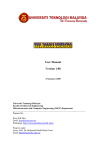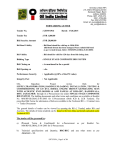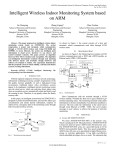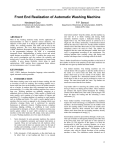Download 441-448
Transcript
Australian Journal of Basic and Applied Sciences, 9(16) Special 2015, Pages: 441-448
ISSN:1991-8178
Australian Journal of Basic and Applied Sciences
Journal home page: www.ajbasweb.com
E-mail Based Kitchen Monitoring System Using a Wireless Sensor Network and GPRS
Module
Mrutyunjaya Sahani, Rishabh Agrawal, Subhashree Subudhi and Aradhana Nayak
Sikha ‘O’ Anusandhan University Bhubaneswar, India, Research Scholar Siksha ‘O’ Anusandhan University, Bhubaneswar, India
ARTICLE INFO
Article history:
Received 20 January 2015
Accepted 02 April 2015
Published 20 May 2015
Keywords:
E-mail, GSM, Microcontroller, Remote
Monitoring, Sensor, ZigBee
ABSTRACT
An interactive kitchen monitoring system for monitoring environmental parameters,
such as light intensity, room temperature, fire detection, motion detection and LPG gas
level, has been developed. This system can monitor the status of kitchen and send an
alert SMS via GSM network and/or an E-mail automatically to a concerned authority, if
the conditions get abnormal. The concerned authority can control the system through
his mobile phone by sending AT Commands to GSM MODEM or by taking the
necessary steps in user E-mail, which is password protected. This system finds a wide
application in areas where physical presence is not possible all the time. The ZigBee
device and ARM1176JZF-S microcontroller are used in the implementation of sensor
module. The system offers a complete, low cost, powerful and user friendly way of
real-time monitoring and remote control of kitchen. A prototype model is developed
and tested with high accuracy result.
© 2015 AENSI Publisher All rights reserved.
To Cite This Article: Mrutyunjaya Sahani, Rishabh Agrawal, Subhashree Subudhi and Aradhana Nayak, E-mail Based Kitchen Monitoring
System Using a Wireless Sensor Network and GPRS module. Aust. J. Basic & Appl. Sci., 9(16): 441-448, 2015
INTRODUCTION
Home automation represents a potential research
area, and their significance is growing rapidly
because of rise in community demand. With the
advancement in Internet technologies and Wireless
Sensor Networks (WSN), a new trend in the era of
ubiquity is being realized. Enormous increase in
users of Internet and modifications on the internet
working technologies enable networking of everyday
objects (Surie, 2008). Humans usually inside their
home interact with the environment settings like
light, air, etc., and regulate them accordingly. If the
settings of the environment can be made to respond
to human behavior automatically, then there will be
several advantages. The automation of home settings
to act according to the inhabitant‟s requirement is
termed as intelligent home automation system.
Ambient intelligence responds to the behavior of
inhabitants in home and provides them with various
facilities (Eisenhauer, 2009).
In general, intelligent home automation system
consists of clusters of sensors, collecting different
types of data regarding the residents and utility
consumption at home. Several systems using
Bluetooth, Infrared (IR), ZigBee and Radio
Frequency Identification System (RFID) based
communication protocols have already been utilized
to monitor homes wirelessly within a short range. For
example, the Bluetooth technology was utilized to
build an intelligent home security system (Liang
Hsu, 2009). In addition, remote-controllable power
outlet system for home power management (ChiaHung Lien, 2007), a networked monitoring system
for home automation (Guangming Song, 2007) and
intelligent home appliance control system (HyungBong Lee, 2010) have also been proposed. An IR
interactive remote control of legacy home appliances
through a virtually wired sensor network has also
been reported (Chun-Liang Hsu, 2010).
ZigBee–based technology has been used in local
monitoring and controlling of home appliances
within homes. For example, ZigBee-based remote
information monitoring devices for smart homes and
home automation systems were developed and
reported (Zualkernan, Gill, 2009; Gao Mingming,
2010). Monitoring and protection building electrical
safety system utilizing ZigBee was also presented
(Li-Chien Huang, 2011). RFID technology has also
been utilized in home automations (Ching-Hu, 2011),
homes safety (Hui-Huang Hsu, 2010; Xuemei, 2008)
and health monitoring systems for elderly in nursing
homes (Dong-Her Shih, 2010). The above wireless
local range monitoring systems have been extended
to a wider remote range using GSM/GPRS networks
(Gao Mingming, 2010) and wireless TCP/IP based
communications (Dong-Her Shih, 2010). In addition,
a low cost wireless gateway utilizing a GSM/GPRS
Corresponding Author: Mrutyunjaya Sahani, Assistant Professor Siksha „O‟ Anusandhan University India, Rishabh
Agrawal, Subhashree Subudhi and Aradhana Nayak Research Scholar Siksha „O‟ Anusandhan
University, India
442
Mrutyunjaya Sahani et al, 2015
Australian Journal of Basic and Applied Sciences, 9(16) Special 2015, Pages: 441-448
based system to monitor fire and door knobs were
reported (Zhao, 2008) and many others to mention.
The above mentioned systems are utilized for local
monitoring or remote monitoring using wireless
components like wireless access points and
GSM/GPRS modems.
The paper proposes a Raspberry pi based kitchen
monitoring system through E-mail with ZigBee
based technology. Raspberry Pi is a single board
computer developed by Cambridge University. The
Pi has been extremely popular among the academic
fraternity due to its low cost. The model B+ of the Pi
ships with 512MB of RAM, 2 USB ports and an
Ethernet port. It packs an ARMI176JZF-S 700 MHz
processor, Video Core IV GPU into the Broadcom
BCM2835 System on Chip which is cheap, powerful
and also low on power. The Pi has HDMI support
and has an SD card slot for booting up due to lack of
BIOS and a persistent memory (Maik Schmidt,
2012).
In this paper, we have described a novel design
and implementation of a compact wireless sensor
network with internet (E-mail) capability. The
system can monitor the status of kitchen and send E-
mail and/or an alert SMS via GSM network
automatically to users. The system has the capability
to control through internet (E-mail), where the
subject of received E-mail is read by the developed
algorithm fed into Raspberry pi and then the system
responds to the corresponding instruction with high
security. It has a variety of features such as energy
efficiency, intelligence, low cost, portability and high
performance.
System architecture:
The kitchen monitoring system hereby reported
consists of two components (Fig. 1), Wireless Sensor
Network units (WSNs) and a Wireless Information
Unit (WIU) linked by radio transceivers that allow
the transfer of temperature, light intensity, motion
detection, fire detection, LPG gas detection data,
implementing a WSN that uses ZigBee technology.
The WIU also has a GPRS module to transmit the
data via the public mobile network. Raspberry Pi has
been chosen as the processing unit of WIU. Python
coded Algorithm has been fed into it and is
connected to the internet to access and send E-mail to
the consumers.
(a)
(b)
Fig. 1: Layout of the proposed system configuration; (a) Wireless Information Unit, (b) Wireless Sensor Unit.
Proposed Algorithm:
The virtual home is a software construct
developed in python. The virtual home is
implemented on the home gateway. All
communication and instructions are checked, as
illustrated in Fig. 2, for security and safety in the
virtual environment before implementation in the
real home environment.
The virtual home waits for input from an
external source. All the devices on the ZigBee
network incorporate the ZigBee microcontroller and
a dedicated raspberry pi. If the conditions get
abnormal raspberry pi sends an E-mail and/or alert
SMS to concerned authorities. Once the security Email has been received, the virtual home checks the
safety implications of the E-mails. After decryption
the destination device address is extracted from the
E-mail and is checked for its existence in the device
database. Once the device‟s existence on the network
has been established, the subject included in the Email is extracted. The existence of the command for
the respective device is checked to ensure the real
443
Mrutyunjaya Sahani et al, 2015
Australian Journal of Basic and Applied Sciences, 9(16) Special 2015, Pages: 441-448
device offers the requested functionality. The
extracted parameters are compared against
predefined safe ranges for the respective device and
command. Only after the E-mail has been processed
by the virtual home algorithm for security and safety,
and declared safe, the E-mail is re-encrypted and
forwarded to the real home network device.
Start Virtual
Home
No
Input Event
Yes
Send E-Mail to users
No
Check for unread
E-mail
Yes
Authenticate E-mail
Unsuccessful
Authentication
Notify the Head user
Successful
Does extracted
address exist in device
database?
Extract destination device
address from E-Mail subject
No
Yes
Extract Parameters from subject
Yes
Send Instruction to home
network
Do the parameters
fall within limit?
No
End
Fig. 2: Flowchart of the control algorithm.
System Description:
The remote measurement and controlling of
home devices over the Internet can be mechanized by
following certain network architectural design
strategies and applying ZigBee communication
standards. The data transmission of smart sensing
devices augmented with ZigBee over the internet can
be done by integrating an internet gateway with
ZigBee network. In a ZigBee network, end devices
collect and forward data to a coordinator and then the
ZigBee protocol data format is translated to Internet
protocol (IPV6) format by the gateway.
The Raspberry Pi unit and the associated sensors
are installed in a home through ZigBee and the
threshold for each of the analog input is configured.
If an abnormality is sensed, the Raspberry pi sends
an E-mail indicating the status of the monitored
sensors to an Internet-based server using the user Email-id. The system then sends a Short Messaging
Service (SMS) message to the home owner
informing about the abnormality.
ZigBee Wireless Sensor Network:
In the development of kitchen monitoring
system, ZigBee communication has been used. The
ZigBee device is an energy efficient, highly accurate,
self-configuring,
low
cost,
communication
technology (XBee-PRO, 2013; IEEE 2003). The
communication between the sensor module and sink
module is performed from side to side a ZigBee
444
Mrutyunjaya Sahani et al, 2015
Australian Journal of Basic and Applied Sciences, 9(16) Special 2015, Pages: 441-448
module. In this paper, we have chosen the XBee S2
module, which is working in the 2.4 GHz band to
transmit and receive data serially. We have
configured the ZigBee module through X-CTU
software. In our system network, the five sensor
module data converse with the single sink module,
which is coupled to a Raspberry pi. The private area
network ID is same as the developed sensor and the
sink module. If the working of the setup is correct,
the network connection between the sensor modules
and the sink node is automatically established. Every
sensor sends its data to the coordinators for every 4s.
We have used the unlicensed 2.4 GHz frequency
band.
Sensing Units:
We have used five different types of sensors as
sensing units for effective data management on the
IoT networks. The sensing unit measures the
environmental conditioning values such as
temperature, light intensity, etc. Thus, the fabrication
of different types of sensing units enabled remote
monitoring and controlling of household appliances
through IoT gateway and IoT application. Fig. 3(a, b,
c, d, e) depicts the fabricated sensing units used in
the IoT application wherein the data is forwarded
through the IoT gateway integrated with ZigBee
coordinator.
The gas sensor being used has high sensitivity to
liquefied petroleum gas (LPG) (Hanwei Electronics
CO., 2011). This makes the sensor appropriate for a
kitchen. A signal conditioning circuit is designed to
interface the sensor to one of the analog inputs of the
ZigBee module. The sensor can detect the
concentration of LPG between 300-10,000 ppm.
Concentration of gas above 1000 ppm can be toxic
[20]. When the value exceeds this threshold, the
communication module sends an E-mail alert to the
user through Raspberry pi.
The temperature value is acquired by a low cost
temperature sensor, the DS1820. It consists of
several electronic components to interface the
sensors to the one of the input pin of ZigBee module.
It can measure temperature from -55C to +125C. A
light sensor is chosen for determining the light
intensity, which also communicates through ZigBee
interface. The sensor output is converted to digital
value from which illuminance or the ambient light
level in Lux is calculated using an empirical formula
to approximate the human eye response. Fire sensor
node is placed in the kitchen. The sensor can detect
fire and send an E-mail and/or SMS and/or to the
base station while sounding the alarms at the same
time. A motion detection sensor (MDS) based on an
infrared receiver is used (Vishay Semiconductors,
2001). It is interfaced to digital input pins of ZigBee
module to monitor the door of the kitchen.
Fig. 3: Wireless sensing unit for Measuring (a) light intensity, (b) Measuring environment temperature, (c) LPG
gas level monitoring, (d) Fire detection monitoring, (e) motion detection monitoring.
IoT Application Gateway:
The transformation of sensing information from
ZigBee to IPv6 network is executed by a program at
the IoT application gateway, as the ZigBee network
does not have the architecture to communicate with
internet protocols. The IoT application gateway
consists of a program for transforming ZigBee
addresses and encapsulating data payloads in an
internet protocol.
The XBee-S2 modules produce sample packets
which are converted to IPv6 User Datagram Protocol
(UDP) packets by the application gateway and sent
to a server. Command packets to control the XBee-
S2 modules are encapsulated in an UDP packet by
the server and are converted to ZigBee packets by the
IoT application gateway.
SMS Module:
The SIM900A is a GSM/GPRS module which
works on various frequencies such as 850MHz, 900
MHz, 1800 MHz and 1900 MHz to send SMS
(Rhydo Technologies, 2011). The modem is
designed with RS232 level converter circuitry which
allows it to be connected to the microcontroller serial
interface. It also has TCP/IP stack which enables the
microcontroller to connect to internet via GPRS. An
445
Mrutyunjaya Sahani et al, 2015
Australian Journal of Basic and Applied Sciences, 9(16) Special 2015, Pages: 441-448
SMS activation system is implemented, which
detects abnormal behaviour and communicates with
a remote tele-care centre, the clients, and their
caregivers (Barnes, 1998).
The SMS module consists of a GSM modem and
a control program. The control program, GSM-dial
up and communication protocol are stored in the
embedded gateway and the GSM modem is
connected to the Raspberry pi via serial interface to
the switching module. The SMS module acts as an
interface between the embedded processor and the
GSM network, enabling the system login to the
network and making the system ready for any data
transfer and communication. The module takes the
AT command from remote terminal or mobile
devices and sends them to switching module via the
GSM network.
Experimental Results:
The experimental setup shown in Fig. 9 is
polling the kitchen environment, when any parameter
exceeds its threshold value, the WIU sends the
warning notification E-mail and/or SMS indicating
the update parameter (temperature, in this case) value
to the authorized users and the user then sends mail
to WIU for controlling action as shown in Fig. 4 to
Fig. 7, respectively.
Fig. 4: Screen shot of "WARNING NOTIFICATION" from Raspberry Pi.
Fig. 5: Screen shot of "INBOX" received on Raspberry Pi
Fig. 6: Step by step usage of the mobile notification program.
446
Mrutyunjaya Sahani et al, 2015
Australian Journal of Basic and Applied Sciences, 9(16) Special 2015, Pages: 441-448
Fig. 7: Screen shot of "SENT MAIL" from Raspberry Pi
The algorithm reads the subject, and checks the
existence and safe range of the devices wirelessly
before forwarding the same to WSN. If the system
satisfies the safety and security limits then WIU will
forward the controlling command to WSU wirelessly
to perform the switching action. For example, an Email with the subject ON1 was sent to Raspberry pi
account ('[email protected]' in this case) from
the
consumer
account
(„[email protected]', in this case).
The algorithm read the subject „ON1‟ at WIU
and sent the command to WSN to turn ON the device
1 represented by Switching Device and instantly
replied to the sender by an E-mail - 'Switch l turned
ON' under the subject- 'Notification on Home
Automation'. Fig. 7 shows the screen shot of sent
mail from WIU to the sender indicating the details of
action performed. The code also notifies the security
breach to prevent unauthorized users to access the
system as shown in Fig. 8.
So the result shows that E-mail based kitchen
monitoring
system
has
been
successfully
implemented efficiently and reliably.
Fig. 8: Screen shot of "SECURITY NOTIFICATION" from Raspberry Pi.
Fig. 9: Working Experimental setup. (a) Wireless sensing unit responding to E-mail with subject „ON1‟i.e.
447
Mrutyunjaya Sahani et al, 2015
Australian Journal of Basic and Applied Sciences, 9(16) Special 2015, Pages: 441-448
Switching Device is glowing representing the
switching signal for switch 1, (b) Wireless
information
unit
having GSM modem, Raspberry pi, ZigBee
coordinator, monitor, keyboard and mouse.
Conclusion:
This paper presents the design and
implementation of an interactive kitchen monitoring
system with GSM, ZigBee communication and Email features.
GSM is an excellent choice for this due to its
extensive coverage. Since SMS is a text based
protocol, even the most basic GSM systems can have
access to the status of the devices or can make
changes on these states. The complete system is
secured through a login E-mail password based
authentication. ZigBee communication makes the
system installation easy. The design is completely
wireless and is integrated with the software to form a
low cost, robust and easily operable system.
The monitoring and automatic control of
equipment through LAN or Internet is forming a
trend in automation field. An existing monitoring
system can be connected to Internet by sophisticated
embedded processor to extend its function. Replacing
PC with low-cost single chip processor can make
administrators get parameters of different remote
sensors and send control information to field
equipments at any time through Internet. The E-mail
controlled duplex communication system provides a
powerful decision making device concept for
adaptation to several smart kitchen scenarios.
REFERENCES
Barnes, N.M., N.H. Edwards, D.A.D. Rose and
P. Garner, 1998. "Lifestyle monitoring technology
for supported independence," Comput. Control Eng.
J., 9: 169-174.
Chia-Hung Lien, Ying-Wen Bai, Ming-Bo Lin,
2007. “Remote-Controllable Power Outlet System
for Home Power Management,” IEEE Trans.
Consumer Electron, 53(4): 1634-1641.
Ching-Hu, Lu., Wu. Chao-Lin, Fu. Li-Chen,
2011. “ Reciprocal and Extensible Architecture for
Multiple-Target Tracking in a Smart Home,” IEEE
Trans. on Systems, Man, and Cybernetics, Part C:
Applications and Reviews, 41(1): 120–129.
Chun-Liang Hsu, Sheng-Yuan Yang, Wu. Weibin, 2010. “3C intelligent home appliance control
system – Example with refrigerator,” Expert Systems
with Applications, 37(6): 4337-4349.
Dong-Her Shih, Hsiu-Sen Chiang, Binshan Lin,
2010. “An Embedded Mobile ECG Reasoning
System for Elderly Patients ,“ IEEE Trans.
Information Technology in Biomedicine, 14(3): 854–
865.
Eisenhauer, M., P. Rosengren and P. Antolin,
2009. “A development platform for integrating
wireless devices and sensors into ambient
intelligence systems,” in Proc. 6th Annu. IEEE
Commun. Soc. Sensor, Mesh Ad Hoc Commun.
Netw. Workshops, pp: 1–3.
Gao Mingming, Shaoliangshan, Huixiaowei,
Sunqingwei, 2010. “The System of Wireless Smart
House Based on GSM and ZigBee,” in Proc.
ICICTA‟10, 3: 1017–1020.
Gill, K., Shuang-Hua Yang, Fang Yao, Lu. Xin,
2009. “A Zigbee-based home automation system,”
IEEE Trans. Consumer Electron, 55(2): 422–430.
Guangming Song, Zhigang Wei, Weijuan
Zhang, Aiguo Song, 2007. “ Design of a Networked
Monitoring System for Home Automation,”, IEEE
Trans. Consumer Electron, 53(3): 933–937.
Hanwei Electronics CO., LTD, 2011. “MQ-5
GAS Sensor,” Technical Datasheet, pp: 1-2.
Hui-Huang Hsu, Po-Kai Chen, Chi-Yi Lin,
2010. “RFID-based danger prevention for home
safety,”, in Proc. ISAC‟, 10: 56–60.
Hyung-Bong Lee, Lae-Jeong Park, Sung-Wook
Park, Tae-Yun Chung, Jung-Ho Moon, 2010.
“Interactive Remote Control of Legacy Home
Appliances through a Virtually Wired Sensor
Network,” IEEE Trans. Consumer Electron, 56(4):
2242-2248.
IEEE Standard for Information TechnologyTelecommunications and Information Exchange
Between Systems-Local and Metropolitan Area
Networks, IEEE Standard 802.15.4-2003, 2003.
Liang Hsu, Sheng-Yuan Yang, Wei-Bin Wu,
2009. “Constructing intelligent home-security system
design with combining phone-net and Bluetooth
mechanism,” in Proc. ICMLC „09, 6: 3316–3323.
Li-Chien Huang, Hong-Chan Chang, ChengChung Chen, Cheng-Chien Kuo, 2011. “A ZigBeeBased Monitoring and Protection System for
Building Electrical Safety,” Energy and Buildings,
43(6): 1418-1426.
Maik Schmidt, Pi. Raspberry, 2012. A Quick
Start Guide. Dallas, Texas: The Pragmatic
Bookshelf, pp: 11-42.
Rhydo
Technologies,
2011.
"SIM900
GSM/GPRS RS232 Modem – User Manual".
Surie, D., O. Laguionie and T. Pederson, 2008.
“Wireless sensor networking of everyday objects in a
smart home environment,” in Proc. Int. Conf. Intell.
Sensors, Sensor Netw. Inf. Process, pp: 189–194.
Vishay Semiconductors, 2001. “Photo Modules
for PCM Remote Control Systems”, Technical
Datasheet, pp: 1-8.
XBee-PRO, RF., 2013. Module. Digi Int. Inc.,
Hopkins, MN, USA.
[Online].
Available:
http://www.digi.com, accessed Jun. 15.
Xuemei, Li., Xu. Gang, Li Li., 2008. “RFID
Based Smart home architecture for improving lives,”
in Proc. IWASID‟08, pp: 440-443.
Zhao, Y. and Z. Ye, 2008. “A Low Cost
GSM/GPRS Based Wireless Home Security
448
Mrutyunjaya Sahani et al, 2015
Australian Journal of Basic and Applied Sciences, 9(16) Special 2015, Pages: 441-448
System,” IEEE Trans. Consumer Electron, 54(2):
567-572.
Zualkernan, A.R., Al-Ali, M.A. Jabbar, I.
Zabalawi, A. Wasfy, “InfoPods: Zigbee-based
remote information monitoring devices for smarthomes,” IEEE Trans. Consumer Electron, 55(3):
122–1226.









